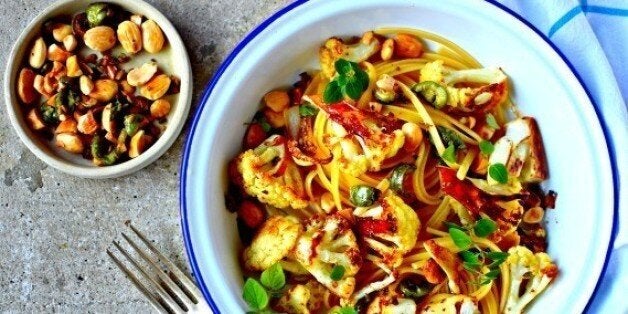
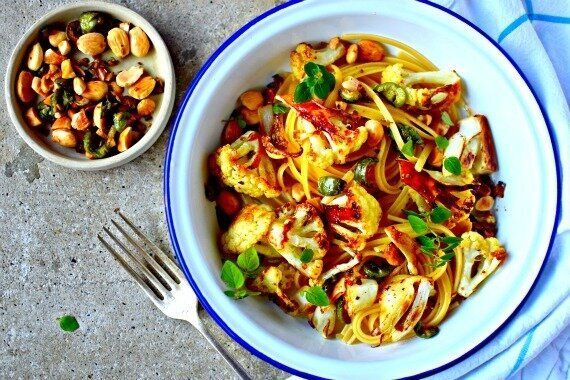
Cauliflower as ugly duckling: a history
Cauliflower is the ugly-duckling-turned-swan of the food world. This is indisputable.
You may be thinking, "Whoa, hang on a sec. Isn't kale still king? Aren't we still talking about kale?... Hey, should I be making cauliflower crisps now?"
Yes, yes and come back to me later.
But, whereas kale is a relative newcomer to the average Joe dinner table, cauliflower has until recently been the steamy, grey horror served up only to be scraped into the bin. School dinner ladies, chefs, grannies, mums: they were all in on the conspiracy to besmirch the now-lauded cruciferous wunderkind. Boiled until the consistency of setting wallpaper paste and the aroma of rancid gym socks, poor old cauliflower has spent a long time treading (boiling) water. And now of course top chefs are building main dishes around this curdy, white wonder.
So, what happened?
Yes, how is that it that, from 2000-2010, UK sales of cauliflower fell 35% ; and industry mag, The Grocer noted that cauliflower suffered from being seen as "old-fashioned," "difficult to cook," and lacking in versatility, cauliflower staged such a remarkable reversal of appeal?
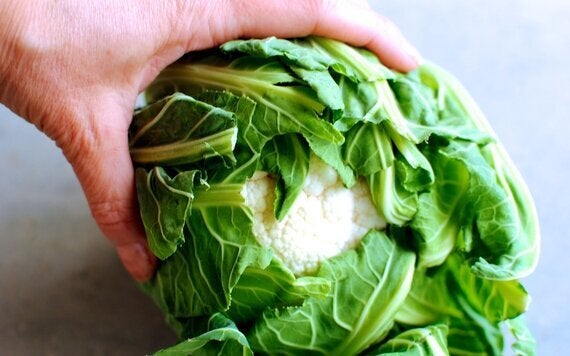
Cauliflower as Ryan Gosling.
The trajectory gets stranger. Suddenly, almost out of nowhere, 2015 was hailed the year of the cauliflower, and continues into this year. To wit, The Washington Post two weeks ago produced the fear-inducing headline, "Cauliflower is so hot right now you may not be able to afford it - or find it".
On seeing this news I can almost picture dumpster-diving Manhattanites (or, more accurately, their nannies) fishing around for tossed out caulis. ;-)
So, basically, it as if the oboe-playing kid who sat at the nerd table grew up to be Ryan Gosling.
I can't be sure but I would bet that the annoyingly-pervasive but slightly useful fad for carb-restricting diets, fasting and other forms of self-induced deprivation has lead the change. (How crass must we seem to those with barely enough food to feed themselves and family?)
Do you agree?
Contrary to those who have said it is not versatile, near-limitless delights can be made with the humble cauliflower. Appropriately frugal in both expense and calories, cauliflower is a fairly magical vegetable. With little effort the pretty pale curds can be transformed into mashed potato, couscous, rice, savoury cake, sweet (chocolate!) cake, "Buffalo bites", "tater tots" and pizza, as well as being an equal partner in the UK's number one comfort food, cauliflower cheese.
And, so it happened, the cool paleo and low-carb kids befriended the lowly, stinky cauliflower and have been clamouring for it - whole, roasted and burnished with spice - ever since.
A tale of happily ever after? Probs not, but let's enjoy it while we can - along with real rice, real potatoes, real crisps, real chocolate cake. :-)
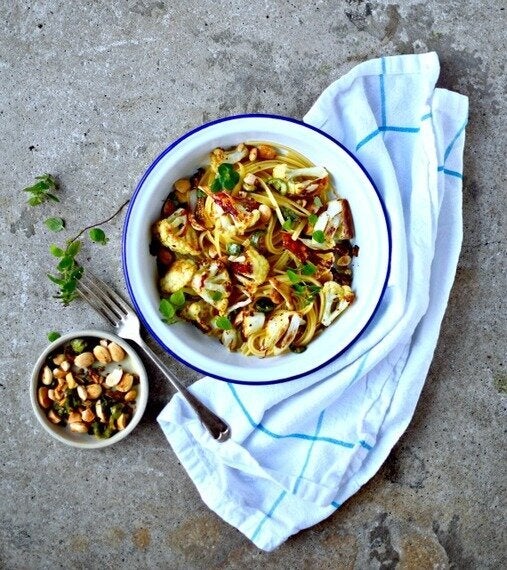
Umami Roasted Cauliflower and Pasta
When going as simple as this recipe, quality ingredients are a must: buy the best olives, almonds and olive oil that you can afford. Also, I used quinoa pasta, but I also really like both spelt pasta and Italian, egg-enriched Durum wheat pasta. If you can get chickpea pasta, that's really delicious, too.
Make extra: If you like, make twice as much of the umami cauliflower and add-ins, adding it to leftover or pre cooked quinoa or freekeh for a most unusual and satisfying brownbag lunch.
1 medium cauliflower - about 500g trimmed, prepared weight (include some tender stem too)
2 tsp lemon juice + extra for serving if you wish
1 rounded tsp Marmite or other yeast extract spread
2 tbsp extra virgin olive oil + 1 tsp (and extra for serving if you wish)
1 tsp fennels seeds, lightly crushed
½ tsp chilli flakes
16 best quality green olives (I use Nocellara "Sicilian Queen"), stone out and halved
60g raw almonds, chopped OR blanched Marcona almonds (my preference)
50-75g dried pasta - I used quinoa spaghetti
1 tbsp (+) fresh Greek oregano leaves or chopped regular oregano
What you need: 1 baking tray; small sauté pan, large saucepan
1. Preheat the oven to 200C/400F.
2. Add the Marmite (it is quite sticky and gloopy) and lemon juice to the sauté pan or a small saucepan (or bung in a bowl and microwave for 15 seconds) and heat just enough to make it easier to mix; whisk in the 2 tablespoons of olive oil.
3. Lay the cauliflower on the tray and quickly pour over the Marmite oil before it separates, and toss well; sprinkle over the crushed fennel seeds and chilli flakes. Pop the tray in the pre-heated oven and roast for 20 minutes, or until starting to brown in places, turning halfway through if you like (I don't always and that's fine).
4. Meanwhile, cook the pasta according to packet directions, shaving off some time to make it al dente** (see below).
5. While the pasta is cooking and cauliflower is in the oven, wipe out the sauté pan, add the remaining oil and heat over a low-medium flame. Add in the olives and almonds when the oil is hot; sauté until the almonds are starting to brown.
6. Divide the cooked, drained pasta between two plates and top with the cauliflower, followed by the olives and nuts, then garnish with the oregano. Squeeze over some extra lemon and drizzle over more olive oil if you like. Serve.
** Resistant Starches: Pasta - and other starchy carbohydrates - generally has less impact on blood sugar levels if al dente or cooked and reheated from cold. The latter especially is very good for producing very desirable resistant starches. This article from authoritynutrition.com explains resistant starches and their benefits, although some of the claims are a bit premature, imo. And I wouldn't recommend eating raw potatoes. ;-) Other, scholarly, articles on RS are online, but require a subscription to access.
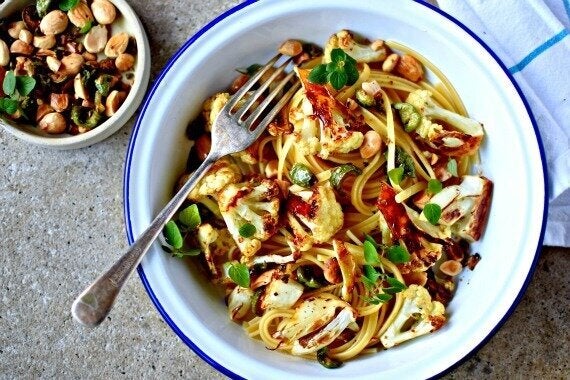
For more accessible, plant-centred recipes without the pseudo-science, visit Kellie's blog, kelliesfoodtoglow.com,Twitter, Facebook, Pinterest and Instagram.